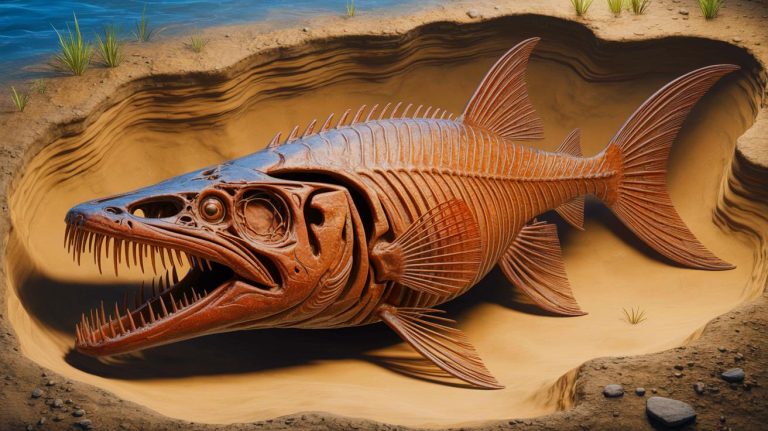| IN A NUTSHELL |
|
In an exciting breakthrough, scientists have unearthed a 225-million-year-old fish fossil in Texas, offering significant insights into evolutionary biology. This discovery reveals the remarkable similarities between ancient predators and modern-day fish, despite their evolutionary paths diverging millions of years ago. The study, carried out by researchers at Virginia Tech, highlights how nature often arrives at similar solutions to survival challenges. Specifically, the elongated jaws of the newly discovered Saurichthys justicias show striking resemblances to those of present-day pike and needlefish, despite evolving from an entirely separate lineage. This finding opens new doors in understanding the evolutionary adaptations of ancient aquatic life.
The Discovery and Analysis of Saurichthys Justicias
The discovery of Saurichthys justicias was made possible through meticulous research at an ancient riverbed near Justiceburg, Texas. The site is renowned for preserving fossilized fish remains, offering a window into the distant past. By employing a method called screenwashing, scientists were able to locate the fossil by sifting through sediments and analyzing them under a microscope. Once identified, the jawbone underwent detailed examination using micro-CT scanning. This advanced technique allowed researchers to create a 3D model of the predator, revealing it as a streamlined creature approximately 1 foot in length, with sharp, narrow jaws.
This new understanding of the Triassic-era predator underscores the repeated evolution of certain physical traits among fish, such as elongated jaws. These adaptations are seen in modern ambush predators like pike, despite the ancient fish belonging to a different lineage of ray-finned fishes. Such discoveries are crucial for comprehending the evolutionary journey of vertebrates and the repeated emergence of similar features in response to environmental pressures.
Implications for Evolutionary Biology
The fossil of Saurichthys justicias provides a rare glimpse into the evolutionary mechanisms that have shaped life on Earth. The similarities between this ancient fish and modern-day species exemplify how evolution can solve similar challenges in analogous ways. As Jack Stack, the study’s lead author, eloquently put it, “The same evolutionary problem is being solved in the same way. You make yourself into an arrow, and you turn your jaws into a fish trap.” This statement encapsulates the essence of convergent evolution, where unrelated species develop similar traits to adapt to comparable environmental niches.
Understanding these evolutionary patterns is essential for predicting how today’s aquatic organisms might respond to future environmental changes. By studying how ancient fish adapted to their shifting freshwater habitats, researchers can infer potential adaptation strategies for contemporary species facing similar challenges. This knowledge is vital as we navigate the impacts of climate change on aquatic ecosystems, offering a historical perspective to guide future conservation efforts.
Insights into Ancient Ecosystems
The name Saurichthys translates to “lizard fish” from Greek, while justicias is derived from the fossil’s discovery location, Justiceburg. Beyond its nomenclature, this fossil offers valuable insights into the ecological dynamics of the Triassic period. By analyzing such fossils, scientists can reconstruct ancient ecosystems and better understand the evolutionary pressures that shaped them.
The study, published in the Journal of Vertebrate Paleontology, emphasizes the importance of paleontological research in understanding ecological and evolutionary processes. With over half of today’s vertebrate species being ray-finned fishes, discoveries like this one are crucial for piecing together the evolutionary history of one of Earth’s most diverse groups. As researchers continue to uncover the secrets of ancient ecosystems, they pave the way for more informed predictions about the future of our planet’s biodiversity.
Future Research and Exploration
As scientific exploration continues, fossils like Saurichthys justicias serve as a reminder of the intricate tapestry of life that has unfolded over millions of years. Each discovery adds a new piece to the puzzle of Earth’s evolutionary history, offering insights that transcend time. The ongoing research at Virginia Tech and other institutions highlights the importance of interdisciplinary approaches in unraveling the mysteries of the past.
What other secrets lie buried in the sediments of ancient riverbeds? As technology advances and our understanding deepens, what new revelations await in the field of evolutionary biology? With each fossil unearthed, we draw closer to answering these questions, pushing the boundaries of knowledge and expanding our appreciation for the diversity of life on Earth.
Did you like it? 4.6/5 (29)









Wow, who knew fish from 225 million years ago could be so fascinating? 🐠
Is it possible to see the 3D models of the jaw online?
Great article! Thanks for sharing such interesting research. 😊
This is amazing! Evolution never ceases to surprise me. 🔬
Were there any other fossils found at the same site?
Can someone explain what convergent evolution means? 🤔
The name “lizard fish” sounds like something out of a sci-fi movie.